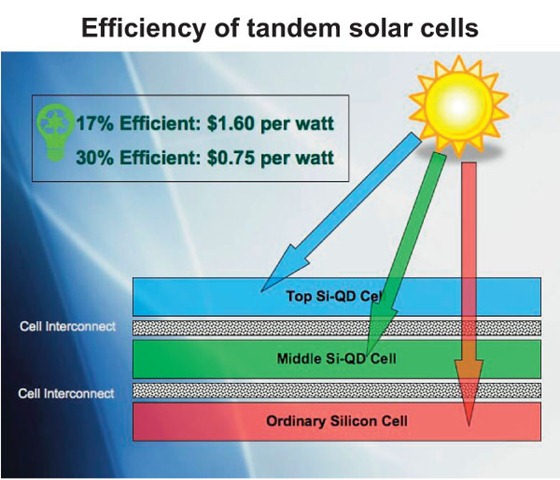Natcore advances tandem solar cell research
 Since its inception, Natcore Technology’s founders have hoped to be able to use the company’s patented liquid-phase deposition technology to build tandem solar cells.
Since its inception, Natcore Technology’s founders have hoped to be able to use the company’s patented liquid-phase deposition technology to build tandem solar cells.
The idea is and has long been to stack three layers of quantum dots on top of each other, each one capturing a different light spectrum, with two junctions connecting them all, said Natcore CEO Chuck Provini.
“By doing that, you can basically double the efficiency of a solar cell,” Provini said. “But the trick is, how do you align all the quantum dots.”
There are three key requirements to building the tandem cells, according to Dr. Dennis Flood, who is leading the research on this project.
First, the quantum dots have to be the right size. Second, they have to form a uniform layer when embedded in a thin film of silicon dioxide. And, finally, they all have to be arranged perfectly with an average inter-dot distance between any two quantum dots of less than 10 nanometers.
“The scientists have successfully met all three requirements,” according to a release from Natcore. “The researchers successfully embedded 20nm-diameter germanium quantum dots inside smooth, round shells of silica, dispersed the coated quantum dots on a surface with a simple spraying technique and coated the layer with a film of silicon dioxide using Natcore’s liquid phase deposition process.”
Natcore partnered with Rice University in Houston to bring this technology to a point where the company can begin working to commercialize it.
“This is a remarkable improvement in photo-generated current in the silica film,” Provini said. “Prof. Barron’s group has done an excellent job moving this from scientific research through proof of concept. Now the researchers at our Rochester R&D Center will focus on developing a working prototype.”
The university doesn’t have a path to commercialization, Provini said.
That’s typically not where universities excel. They are good at developing the research and proving technologies, but now it’s up to Natcore to scale it up, something Provini said the company is capable and ready to do. It already has most of the equipment it will need at its location in the former Kodak facility in Rochester, New York.
Natcore is also working to commercialize black silicon and selective emitter technology, something Provini said it’s on the verge of doing.




